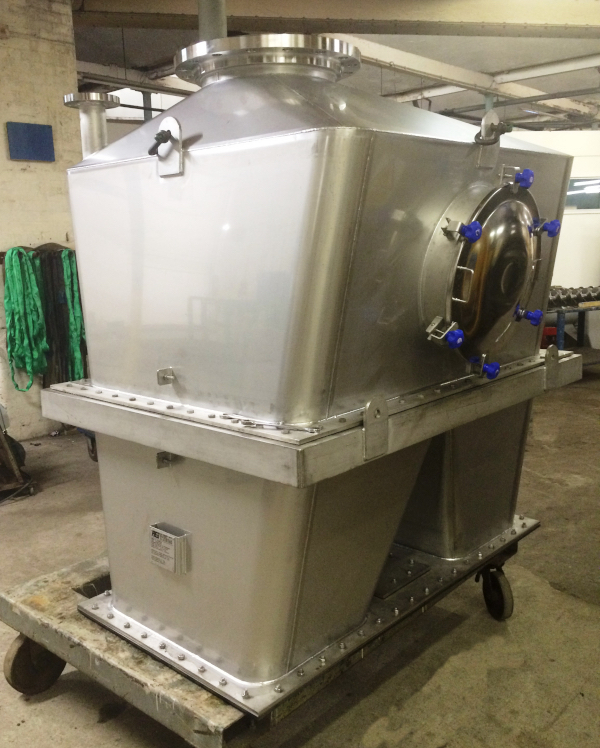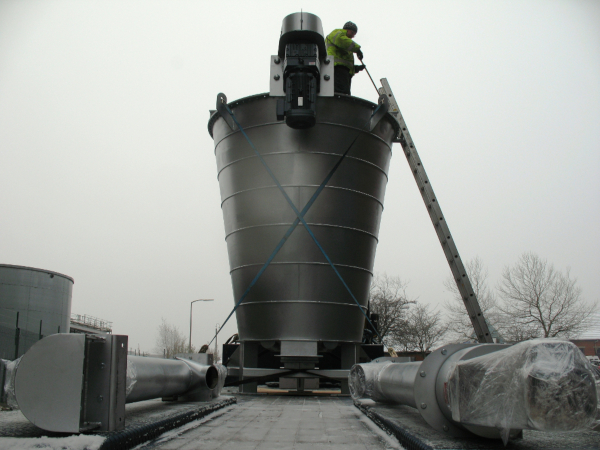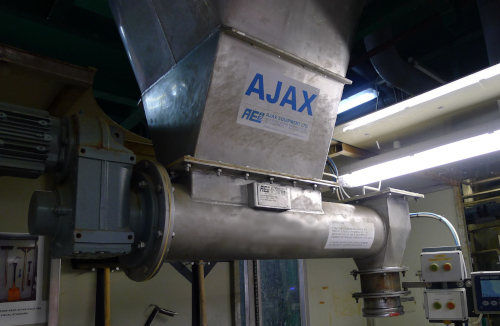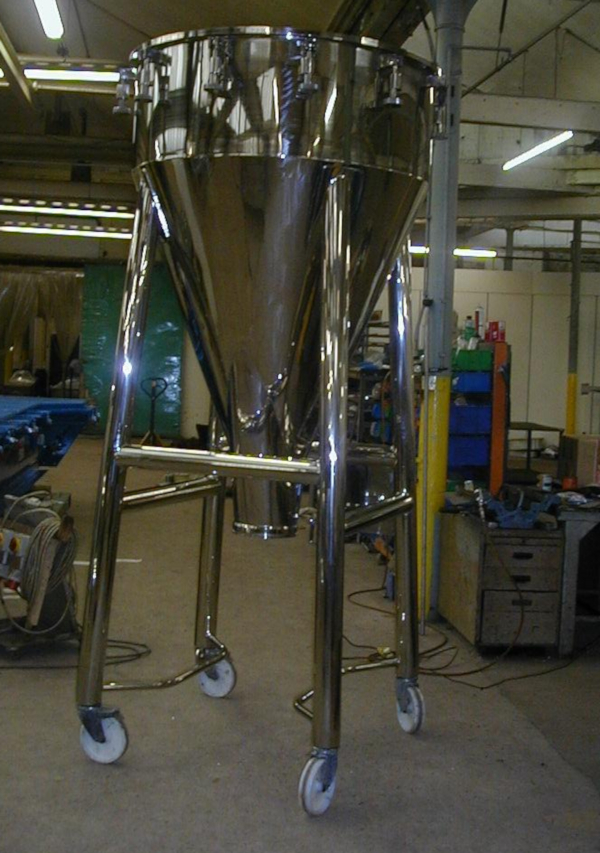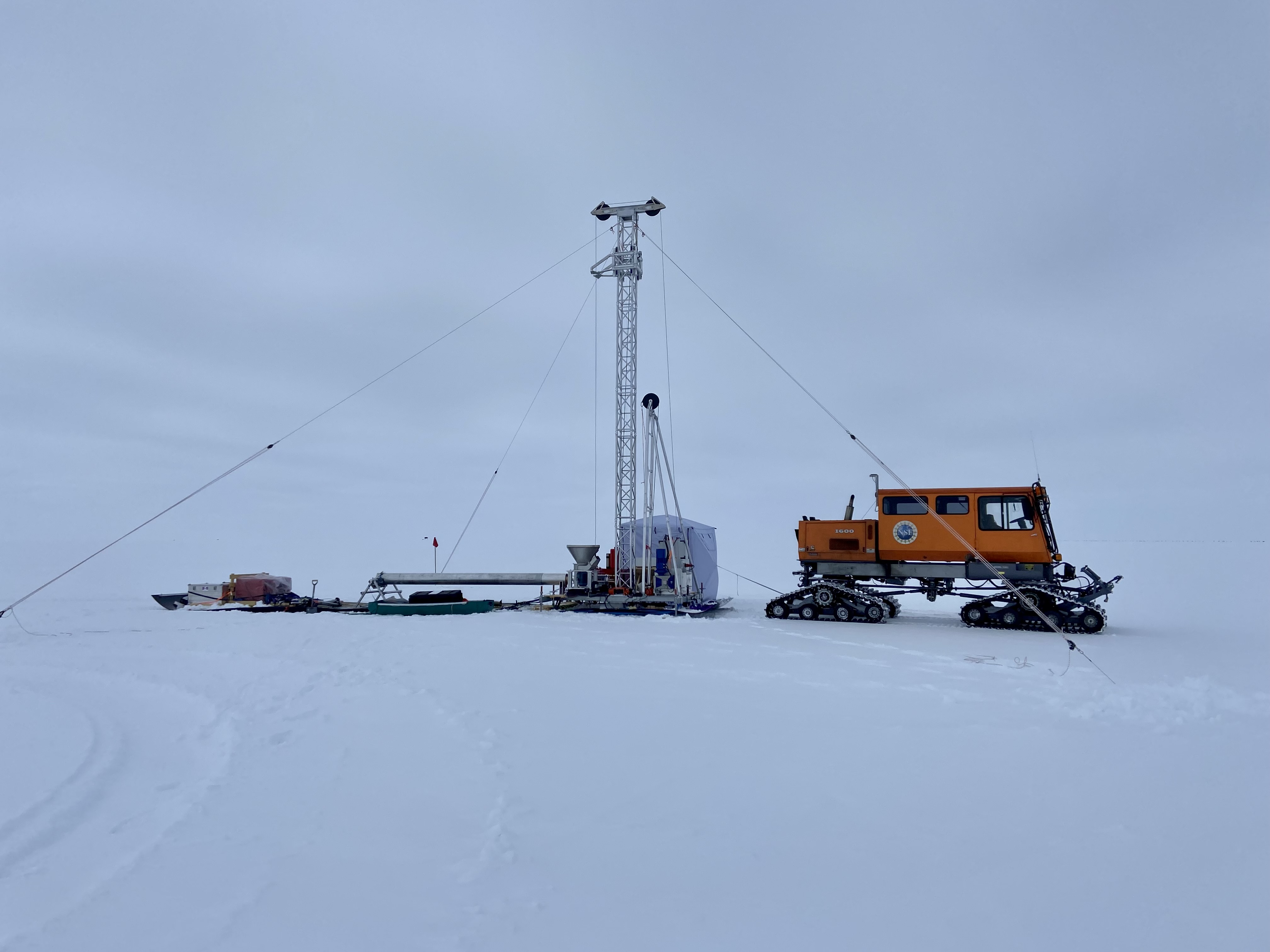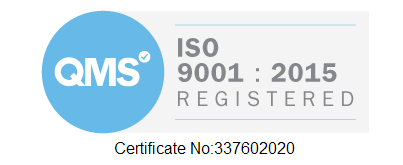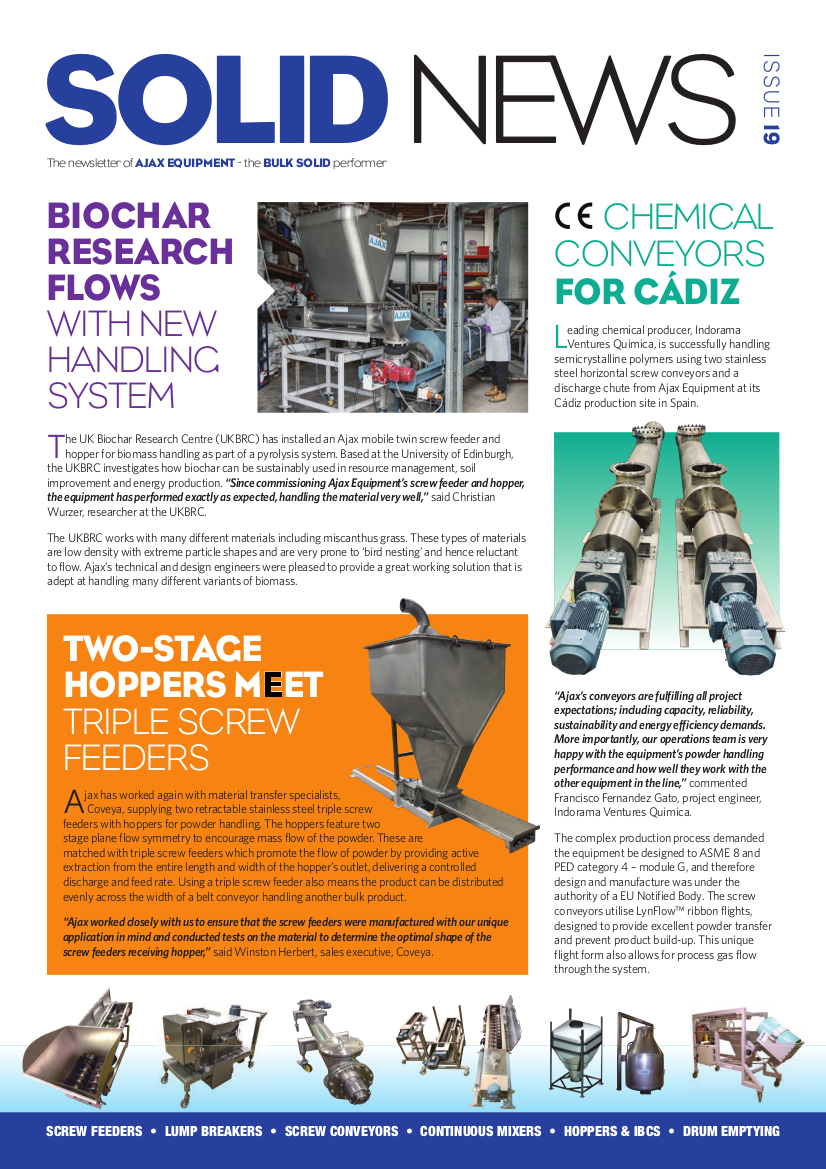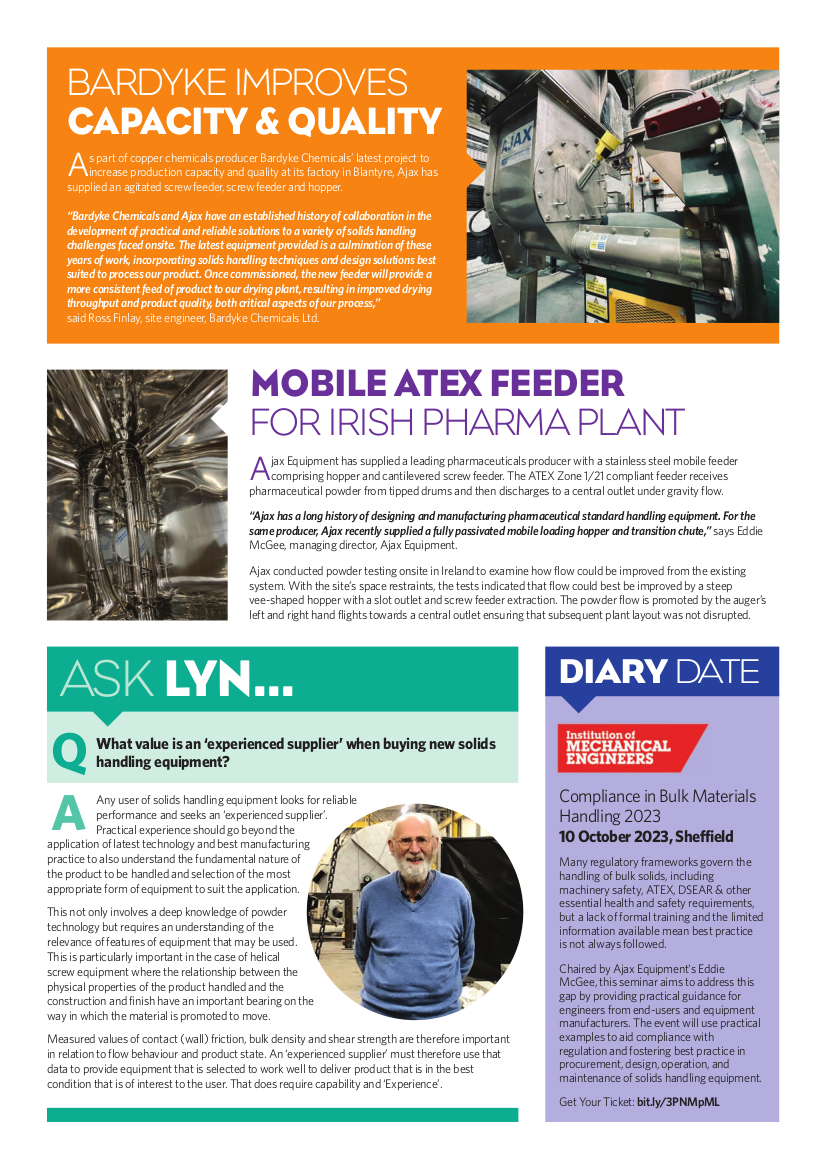Reliable Hopper, Silo and Bin Discharge.
AJAX make various types of equipment for discharging from hoppers, including: -
Bin Activators - For stimulating flow.
Table Feeders - For large circular outlets with rigid connections.
Single & Multiple Screw Feeders - Multi-functional.
Bin Activators
The primary purpose of a Bin Activator is to promote and sustain the discharge of a difficult flow material. The size of unit to be used, its connection diameter, is traditionally based as a proportion of the main hopper diameter, in some empirical ratio related to the degree of flow difficulty that the bulk material affords. The correct method is to select a size greater than the critical arching diameter, for a hopper that is designed for mass flow, or one that is larger than the critical 'rat-hole' size, for a non-mass flow type of hopper. The inclination of hopper wall that is required to generate wall slip, and hence mass flow, is mainly dependent upon the wall friction value for the particular material of construction and the nature of product to be stored. Measurement of this angle of slip, and the optimisation of the contact surface material and finish, can be determined by Ajax from a 'representative' sample of the bulk material, or by the user from use of an Ajax wall friction tester and relevant graphs. (A 'representative' sample in this case is one that represents the worst slip condition of the material that will be experienced in service, another reason for carrying out properly organised tests - to find the 'worst' material conditions).
The size of activator can be reduced for certain special designs of non-mass flow hoppers and hoppers with flow inserts, but these instances rest in the domain of experts.
The essential flexible connection between the Activator and the main hopper precludes the use of Bin Activators for bins the have a potential explosion hazard that work under pressure, or contain hot or hazardous products.
A crude measure of flow rate control is possible is some applications by varying the intensity of the applied vibration. The uniformity and consistency of the discharge rate is highly dependent upon the nature of the bulk material and its condition in the hopper. In most cases the awkward flow condition of the product is the main reason for choosing a Bin Activator, therefore this is not a recommended method of feed control. A separate buffer hopper and screw feeder should be employed where an accurate feed is required. High and low level robes of the receiving hopper start and stop the activator, to maintain a working level range adequate to establish and sustain consistent behaviour of the contents. A mass flow hopper is preferred for this duty for all but the most stable bulk materials, to give the maximum possible residence period for the material before discharge.
Table Feeders
Table Feeders are used to discharge from large diameter circular outlets from hoppers and silos where bin activators cannot be used, a controlled feed is required or multiple discharge points are to be served. Typical applications are for use with materials the present an explosion risk, have hazardous properties or the container may be subject to positive or negative pressure. They are also used to save headroom, by virtue of their compactness.
In their simplest form, (flow promoting, no feed control, non-mass flow), the units have a rotating arm on a flat base, to sweep the material in the hopper round to one or more outlet ports. In this mode it is common for the units to be operated only when the sufficiently free flowing contents have virtually self-drained. The purpose in this use is to save headroom and sometimes provide multiple, and possibly optional, outlets. Without means to reduce over-pressures on large openings, the force required to initiate rotation of large radius arms under a deep bed is considerable. Using the arms only to clear residue after most of the contents have emptied is a much easier task.
Drawbacks of this form of feeder are: - - Where some of the material has discharge by gravity flow, the outlets must be large enough to avoid arching and the formation of rat-holes. The flow pattern in the storage container cannot be of mass flow form. A high torque may be necessary to start the rotation of the arms, even to deal with a residual quantity of material left in the hopper. A method employed to overcome some of these difficulties is to fit an inverted cone in the centre of the table feeder. This will shield the arms, and take much of the compacting load from the material in the base of the hopper. The outlet(s) can extend over the width of the remaining annular gap, permitting total extraction to take place. Fitting a screw feeder under the outlet(s) allows the extraction rate to be controlled. The inverted cones fitted in the Ajax range of Table Feeders, are offset from the centre of the hopper outlet. This creates an increasing width of gap as the arms rotate. This geometry generates a live extraction pattern around one half of the annulus. The extracting screw collection slot extends over the opposing half of the table feeder. These have a progressive form of screw geometry to give flow over the remaining portion of the hopper interface. This design prevents dead regions of flow when discharge takes place and enables the main hopper to be of a mass flow type. Other design features include the divergence of the external shell of the table feeder and cranked ribs that impart a transverse force to the flowing material. These guide the material into a rotary direction and reduce the shear force needed by the arms.
Where two or more feeders are fitted, the inverted cone may be central in the unit. If no feeders are used, the central item may have a spiral form, to offer an increasing width of flow channel as the arms rotate. Variable speed completes the facility for feed rate control, as required.
Ajax offers a complementary powder testing service for the design of associated hoppers.
Screw Feeders
Screw Feeders offer a wide range of benefits with an enormous variety of options. An initial breakdown of the types used to discharge form hopper is to classify them as either: -
'Collecting' screw feeders, as used to discharge dust and plate filters, dump hoppers, and other installations, where the primary function of the screw is to deliver any material that falls into the hopper to a common point. The type of hopper is not normally 'flooded' with product, although where this is a prospect the screw must be able to cope with the power needs and the subsequent equipment with the higher rate of discharge given.
Feed Screws of uniform construction. These feed screws have a common pitch and diameter throughout the length exposed to the hopper contents. The initial portion of screw will fill its cross section and transfer material along the axis, thereby preventing the entry of further material. Because of this initial inflow, extraction from the hopper is limited to a length of slot marginally longer than the first pitch of screw.
Progressive extraction screw feeders. Changes of screw geometry are used to secure incremental transfer capacity along the axis of the feed screw. This construction generates inflow along the full length of the section of screw exposed to the hopper contents, which gives many operational and installation advantages.
Vee shaped hopper forms that accompany the extended collecting capacity of screws, affords increased storage capacity, better flow characteristics than conical or pyramid shaped hoppers and lower wall inclinations for both mass flow and self clearing potential. The flow advantages are also brought out in the ability of flow to take place through a slot width that is approximately half the diameter of a circular outlet. Apart from choice of screw size to select an opening width for a hopper outlet, multiple screws are used to give even wider outlets.
Many options of screw design offer extensive flexibility, which is enhanced by a large number of features favourable to specific duties. As the subject is extensive, we wrote a book to aid the user. This 'Guide to the design, selection and application of Screw Feeders' is available from Professional Publications Ltd. but our technical and design staff are only too pleased to consider your special needs and put forward detailed proposals.
For more information on Ajax’s hoppers and hopper desigh, call +44 (0)1204 386723 or visit our
Hopper Design Page page.
